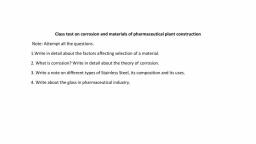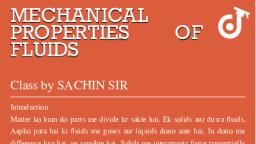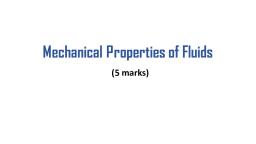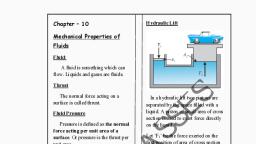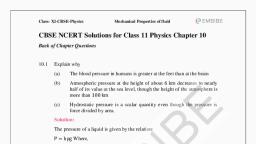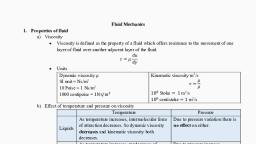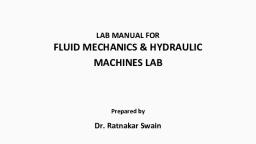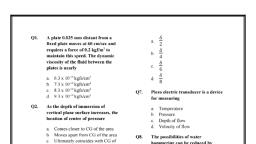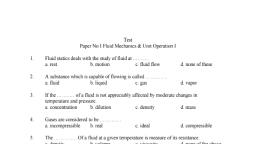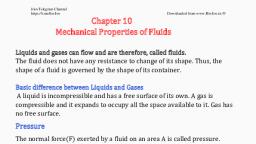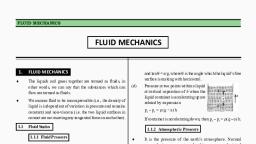Page 1 :
FLOW OF FLUIDS, Fluid is substances which have ability to flow., Ex. Water, gases, Solid—movement but shape does not change., Liquid – movement and deformation in shape., Gas- movement and deformation in shape., So we can say Liquids & Gases are fluids., Fluid pressure –, The pressure which is applies by the fluid., Also known as hydrostatic pressure, Pressure, , =, , =
Page 2 :
P =, , =, , Fluid statics:, Fluid statics deals with the fluids at rest in equilibrium., The behavior of a liquid at rest, the nature of pressure it exerts and the variations of, pressure at different layers in the liquid are some of the relevant aspects in, pharmaceutical engineering., The study of fluids at rest is based on two principles., 1. Pressure at a point is the same in all directions., 2. Pressure is the same at all points in a given horizontal line in a continuous fluid., Fluid dynamics: Fluid dynamics deals with the study of fluids in motion.
Page 3 :
Study of flow properties of liquids is important for pharmacists working in the, manufacture of dosage forms, such as simple liquids, gels, ointments, creams and, pastes. These systems change their flow behavior, when exposed to different stress, conditions as in the following situations., (1) Manufacture of dosage forms: Materials undergo processes such as mixing,, flowing through pipes and getting filled in the containers. Flow-related changes, influence the selection of mixing equipment,, (2) Handling of drugs for administration: The syringe ability of the medicines,, pouring of the liquids, extrusion of ointment from tubes, etc.,, Manometer:, It is a devices which is used to measure pressure difference.
Page 4 :
Type of manometer Simple, Manometer, , Manometer, Differential, Manometer, , Inclined, Manometer, , 1- Simple manometer- These are those manometers which measure the pressure at, any point is a tube etc., Ex. U-tube manometer
Page 5 :
2- Deferential manometer- These are those manometer which used to measure the, pressure difference, Ex., , any two gases/liquids., , U-tube deferential manometer
Page 7 :
P1 - P2 = gh, , Flow = P, I. Steady flow- Liquid flow constantly, II. Turbulent flow- Not in constant flow, Reynolds’ number –, It is the ratio at inertial forces (which increase Reynolds no.) &viscous forces, (which resists)
Page 8 :
Re =, Re =, , Where,, , = Density of fluid., v = Velocity, d = diameter of pipe, = viscosity of fluid., , So, it is used to predict the nature of flat fluid (flow). Also used to study the, sedimentation rate
Page 9 :
Bernoulli’s theorem: Bernoulli’s theorem states that in a steady state ideal flow of, an incompressible fluid, the total energy per unit mass, which consist of pressure, energy, kinetic energy, and datum energy (Potential energy), at any point of the fluid, is constant., ℎ, P = Pressure energy, = Kinetic energy, ℎ = Potential energy, WhereP = Pressure exerted by the fluid, v = velocity of the fluid
Page 10 :
h =height of the point/fluid, = density of the fluid, , Assumptions;
Page 11 :
The density of the incompressible fluid remains constant at both points., , The energy of the fluid is conserved as there are no viscous forces in the fluid., The work done on the fluid at the both point A&B is given as-, , We know, the work done on the fluid was due to conservation of gravitational force, and change in kinetic energy (KE) The change in KE of the fluid is given as:, , …………, The change in potential energy is given as;
Page 13 :
Energy loses: some energy loss during flow., 1) Frichonal loss- During flow of fluids in pipe some frictions apply on fluid by the, walls of pipe. And it opposes the flow and during this some energy loses., , Hagen poiseuille equation:, =, Where,, Pressure loss due to friction, L = Length of pipe, u = velocity of fluid, µ = viscosity of fluid
Page 14 :
D = Diameter., ii) Enlargement loss – when we increases the pipe size, then there are changes of, some velocity, due to this energy loss occurs., iii) Constriction loss - When we decrease the size of pipe, velocity increase, energy, loss.
Page 15 :
4) Fitting loss – When we bend the pipe then flow of fluid’s direction change. And, for changes of direction there is some loss of energy.
Page 16 :
Rate of flow of fluids, i), ii), iii), iv), i), , Orifice meter, Ventury meter, Pitot tube Meter, Rota meter., , Direct, , Orifice meter, The principle based on Bernoulli theorem, An orifice meter is a device which used to measure the rate of flow (speed,, velocity ) through aific plates., Construction:
Page 18 :
g= gravitation face, = pressure difference, So, we can find, (pressure difference) through the manometer which we, attached on pipe., Put the value of pressure difference on orifice meter formula we find out the, velocity f fluid easily., Uses: Used to measure velocity of fluid, Advantages – (1) Simple to use (2) Low cost, especially large sizes.(3) Used to, recalibration, Disadvantages – Maintenance problem, Poor accuracy, , ii) Venture Meter, It is used to measure the rate of low of liquid (speed, velocity ) in a pipe.
Page 19 :
Principle: It is based on the of Bernoulli’s theorem., - Venture meter consists of two tapered section in the pipeline with a gradual, constriction (throat) at its cape., - When fluid is passed through venture meter there are change in pressure head, ( ) and increase in velocity due to compaction of verdure meter (Acc. to, Bernoulli.), Formula;, , U v = Cv, , We can easily find out the velocity of fluid., Construction;
Page 20 :
- It consists of two tapered section inserted in a pipeline with constriction at, meter’s center., - The upstream cone is normally shorter than the downstream.
Page 21 :
- The tapers are smooth and gradual., - A manometer is connected at point A & B to measure the pressure difference, Working, - firstly venture meter is inserted between pipeline., - When fluid is passed through venturimeter , the velocity of the fluid is increased, at the throat, due to the constriction., - This result in decreased pressure in the up-stream cone (or change in pressure, head). Which further calculated through manometer, - NowUv = Cv, , Where,, Uv = velocity of fluid through venturimeter
Page 22 :
Cv = Coefficient of the venture meter, ∆H= Pressure head difference, - Now, put the value of, (which is measured in manometer) in this eq. and, find the velocity of fluid., Uses:- It si commonly used for Liquid ( water) and also for gases., iii) Pitot Tube meter;, It is used to measure the rate of flow of liquid (speed, velocity)/ velocity head., It is the based on the principle of Bernoulli’s theorem., When it inserted into the center of pipe, the velocity of flow is increased at that, point, and change in pressure head, which further calculated through, manometer., The put this value in eq. and find out the value of velocity head., V actual = Cv
Page 23 :
Where,, V act = velocity of fluid (Velocity head), Cv = coefficient of pitot tube, , = Pressure head difference, Constriction:, Also known as insertion meter., Size is small compared to pipe., One tube is perpendicular to the flow direction and the other tube is, connected paroled to the direction of flow.
Page 24 :
Manometer is connected with this to measure the pressure head difference., Working:- Firstly insert the Pitot tube in pipe., - In tube, velocity of fluid is increased due to constrict (narrow) tube, results, decrease (change) in pressure head ( ) difference.
Page 25 :
-, , Measured in manometer and then this value put in the formula and calculate, the velocity head on rate of flow of liquid (fluid)., Vact = Cv, , iv) Rota Meter:, It is a variable area meter i.e. it measures the area of flow so as to produce a, constant head deferential. Therefore, Rota meters are known as area meters., Principle, It consists of a vertical, tapered and transparent tube in which a, plummet is laced., During the fluid flow through the the tube, the plummet6 rides and, falls because of variation in flow.,
Page 26 :
It consists of vertical tapered tube which is mounted with a narrow end down., The tube is visually made of glass and which a line or scale is etched., Solid plummet is placed in the tube (diameter smaller than narrow end of tube.), Plummet/ float may be made of lead, aluminum, glass and plastic., Working:-
Page 27 :
Firstly Rota meter is fitted on the pipe., As the flow is upward through a tapered tube the flow of fluid varies., The plummet, which is surrounded by the fluid, rises and falls depending on the, rote of flow., The greater the flow rate. The higher the plummet rise in the tube., In Rota meters, the pressure drop is constant or nearly constant., The flow may ne read using the upper edge of the plummet ass an indeed (linear, scale)., The reading may be transmitted for recording, integrating. Ad controlling., Uses, Used in chemical industries, such as bulk dregs. Supply of air is controlled, through Rota meter., It is suitable for both gas & liquids.







